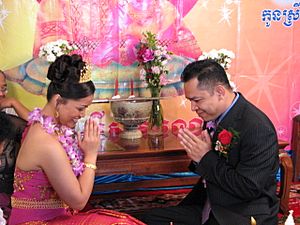Greeting facts for kids
Greetings are special ways people say hello when they meet. They can be words, actions, or even a mix of both! Greetings help us show politeness and respect. They also let others know we are friendly. Different cultures around the world have their own unique ways of greeting each other.
Contents
Verbal Greetings: Saying Hello
Many greetings involve speaking. In the English language, there are lots of common ways to say hello. Some are more formal, while others are casual.
Common English Greetings
- "Hello" or "Hi": These are very common and can be used in almost any situation.
- "Hey": This is a more relaxed and informal way to greet friends.
- "Good morning," "Good afternoon," or "Good evening": These greetings change depending on the time of day. They are polite and can be used formally or informally.
- "What's up?" or "What's happening?": These are very informal ways to greet friends. They are like asking, "How are things going?"
- "G'day": This is a special greeting used a lot in Australia. It's a short way of saying "Good day."
- "Howdy": This informal greeting is often heard in rural parts of the United States.
- "How do you do?": This can be a polite question in some places, or just another way to say hello in others.
Non-Verbal Greetings: Actions Speak Louder
Sometimes, you don't need words to greet someone. Many cultures use actions or gestures to show respect or friendship.
Hand Gestures and Bows
- Handshakes: Shaking hands is a very common greeting in many parts of the world. It shows trust and respect.
- Bowing: In some Asian cultures, like Japan, bowing is a traditional way to show respect. The depth of the bow can show how much respect you are giving.
- Waving: Waving your hand is a friendly way to say hello from a distance.
- Hongi: This is a special greeting of the Māori people in New Zealand. Two people press their noses and foreheads together. It symbolizes sharing the breath of life.
- Namaste: In India and other parts of South Asia, people often greet with a Namaste. They press their palms together near their chest and sometimes bow their head. It means "I bow to the divine in you."
- Kowtow: This is a very deep bow where a person kneels and touches their forehead to the ground. It was historically used in China to show extreme respect or submission.
Other Unique Greetings
- Hat-raising or tipping: In the past, men would lift or tip their Hats to show respect, especially to women.
- Kissing on the hand or cheek: In some European and Latin American cultures, people might kiss a hand or a cheek as a greeting, especially among family or close friends.
- Roman salute: This was a gesture used in ancient Rome, where a person would extend their arm forward with a straight hand. It is now mostly associated with historical events and not commonly used as a friendly greeting.
Why Greetings Are Important
Greetings are more than just saying hello. They help people connect and understand each other. They show that you acknowledge someone's presence and respect them. Learning about different greetings can help you understand and appreciate other cultures around the world.
Images for kids
-
Chinese greeting (拱手) practised by Tsai Ing-wen, President of the Republic of China (Taiwan).
-
Denis Thatcher, husband of former Prime Minister of the United Kingdom Margaret Thatcher, greets former American First Lady Nancy Reagan by kissing her hand, 1988
-
Steven Gerrard performing a Wai
See also
 In Spanish: Saludo para niños
In Spanish: Saludo para niños








